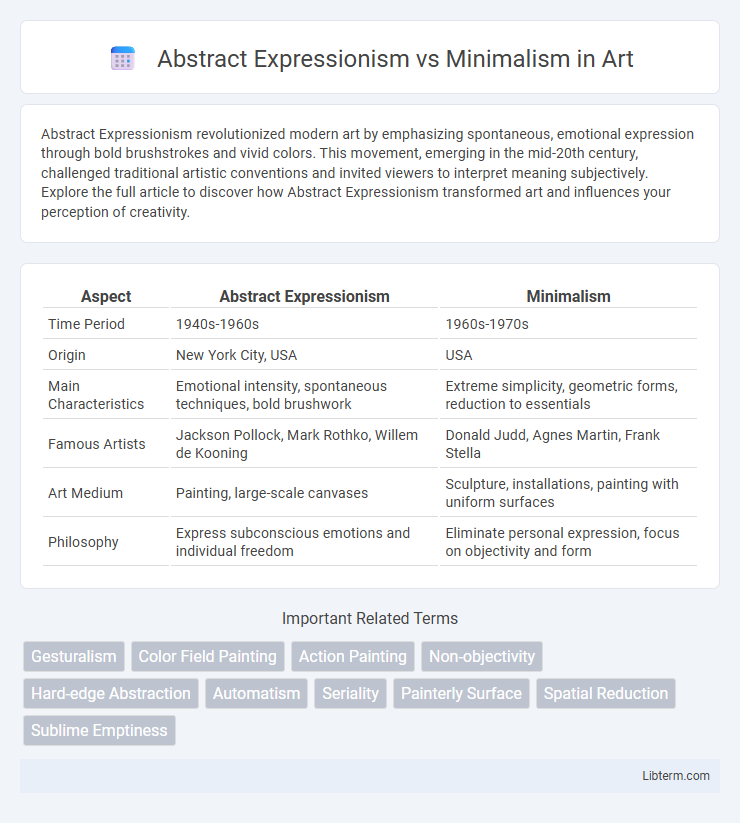Abstract Expressionism revolutionized modern art by emphasizing spontaneous, emotional expression through bold brushstrokes and vivid colors. This movement, emerging in the mid-20th century, challenged traditional artistic conventions and invited viewers to interpret meaning subjectively. Explore the full article to discover how Abstract Expressionism transformed art and influences your perception of creativity.
Table of Comparison
| Aspect | Abstract Expressionism | Minimalism |
|---|---|---|
| Time Period | 1940s-1960s | 1960s-1970s |
| Origin | New York City, USA | USA |
| Main Characteristics | Emotional intensity, spontaneous techniques, bold brushwork | Extreme simplicity, geometric forms, reduction to essentials |
| Famous Artists | Jackson Pollock, Mark Rothko, Willem de Kooning | Donald Judd, Agnes Martin, Frank Stella |
| Art Medium | Painting, large-scale canvases | Sculpture, installations, painting with uniform surfaces |
| Philosophy | Express subconscious emotions and individual freedom | Eliminate personal expression, focus on objectivity and form |
Introduction to Abstract Expressionism and Minimalism
Abstract Expressionism, emerging in the 1940s New York art scene, emphasizes spontaneous, gestural brushwork and emotional intensity, showcasing artists like Jackson Pollock and Willem de Kooning. Minimalism, gaining prominence in the 1960s, focuses on simplicity, geometric forms, and monochromatic palettes, represented by figures such as Donald Judd and Agnes Martin. Both movements revolutionized modern art by contrasting expressive complexity with reductive clarity, influencing contemporary visual culture profoundly.
Historical Context and Origins
Abstract Expressionism emerged in the 1940s New York art scene as a response to the trauma of World War II, embodying intense emotion and individualism through bold brushstrokes and large-scale canvases. Minimalism arose in the 1960s as a reaction against the emotional excess of Abstract Expressionism, emphasizing simplicity, geometric forms, and the reduction of art to its essential elements. Both movements were shaped by shifting postwar cultural landscapes, with Abstract Expressionism reflecting existentialist themes and Minimalism exploring objectivity and industrial materials.
Key Philosophies and Artistic Intent
Abstract Expressionism emphasizes spontaneous, emotive expression and the artist's inner psyche, prioritizing large-scale, dynamic compositions that evoke raw emotion and individuality. Minimalism centers on simplicity, objectivity, and reducing art to fundamental geometric forms, stripping away personal expression to focus on materiality and spatial relationships. These contrasting philosophies reflect Abstract Expressionism's embrace of emotional depth versus Minimalism's pursuit of clarity and universal form.
Visual Elements and Techniques
Abstract Expressionism emphasizes dynamic brushstrokes, vibrant color contrasts, and spontaneous compositions that convey emotional intensity and individual expression. Minimalism employs geometric shapes, limited color palettes, and precise, clean lines to create simplicity and emphasize physical space and materiality. Techniques in Abstract Expressionism often include gestural painting and layering, while Minimalism relies on repetition, industrial materials, and reduction of form to achieve visual clarity.
Notable Artists and Iconic Works
Abstract Expressionism features notable artists like Jackson Pollock, known for "No. 5, 1948," and Mark Rothko, famous for his large color fields such as "Orange and Yellow." Minimalism includes key figures like Donald Judd, recognized for his geometric sculptures like "Untitled (Stack)," and Agnes Martin, celebrated for her subtle grid paintings like "Friendship." These iconic works highlight the intense emotional expression of Abstract Expressionism versus the simplicity and precision central to Minimalism.
Emotional Impact vs. Intellectual Approach
Abstract Expressionism prioritizes raw emotional impact through dynamic brushstrokes, vivid colors, and spontaneous compositions that evoke subconscious feelings. Minimalism emphasizes intellectual engagement by employing simple geometric forms, restrained color palettes, and repetition to encourage contemplation and challenge traditional notions of art. The emotional intensity of Abstract Expressionism contrasts sharply with the cerebral, analytical focus inherent in Minimalist works.
Influence on Contemporary Art
Abstract Expressionism profoundly shaped contemporary art by emphasizing emotional intensity and spontaneity, inspiring artists to explore personal expression and dynamic brushwork. Minimalism countered this with a focus on simplicity, geometric forms, and materiality, influencing contemporary art's engagement with space, structure, and viewer interaction. The dialogue between these movements continues to inform contemporary practices, balancing visceral emotion and conceptual clarity.
Critical Reception and Public Perception
Abstract Expressionism received acclaim for its emotional intensity and innovative techniques, dominating the art scene in the 1940s and 1950s with artists like Jackson Pollock and Mark Rothko hailed as pioneers. Minimalism, emerging in the 1960s with figures such as Donald Judd and Agnes Martin, faced mixed critical reception initially, often criticized for its stark simplicity and perceived coldness compared to the gestural energy of Abstract Expressionism. Public perception shifted over time, with Minimalism gaining appreciation for its focus on form and space, reflecting broader cultural trends toward clarity and reduction, while Abstract Expressionism remains celebrated for its passionate expressiveness and spontaneity.
Lasting Legacy and Evolution
Abstract Expressionism's lasting legacy lies in its emphasis on emotional intensity and individual spontaneity, which reshaped the trajectory of modern art by prioritizing personal expression over traditional form. Minimalism evolved as a reaction to this emotional excess, promoting simplicity, clean lines, and industrial materials, influencing design, architecture, and visual culture. Both movements collectively revolutionized artistic boundaries, fostering new dialogues in abstraction that continue to inspire contemporary artists and shape global art practices.
Choosing Between Styles: Influence on Modern Creators
Abstract Expressionism's dynamic brushstrokes and emotional intensity inspire modern creators seeking to convey personal narratives and spontaneity in their work. Minimalism's emphasis on simplicity, geometric forms, and reduction of elements appeals to artists focused on clarity, structure, and conceptual sophistication. The choice between Abstract Expressionism and Minimalism often shapes contemporary art by influencing creative processes, audience engagement, and the articulation of thematic content.
Abstract Expressionism Infographic

 libterm.com
libterm.com